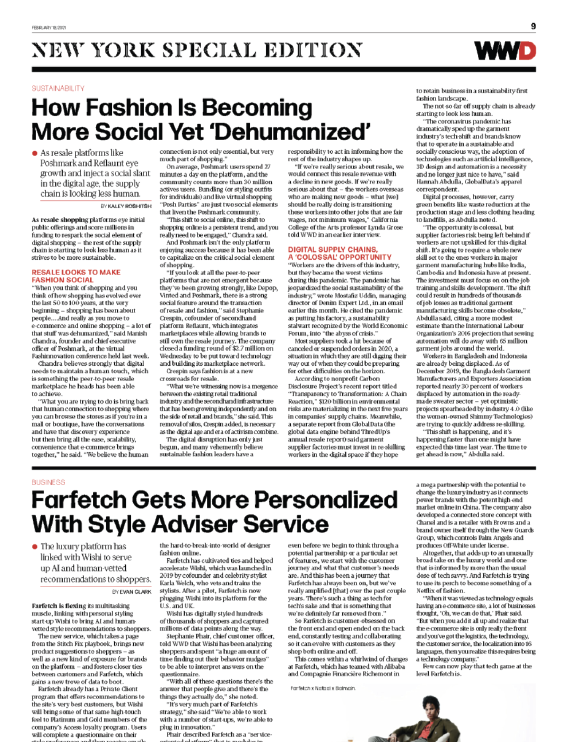As resale platforms like Poshmark and Reflaunt eye growth and inject a social slant in the digital age, the supply chain is looking less human.
BY KALEY ROSHITSH
As resale shopping platforms eye initial public offerings and score millions in funding to respark the social element of digital shopping — the rest of the supply chain is starting to look less human as it strives to be more sustainable.
RESALE LOOKS TO MAKE FASHION SOCIAL
“When you think of shopping and you think of how shopping has evolved over the last 50 to 100 years, at the very beginning — shopping has been about people.…And really as you move to e-commerce and online shopping — a lot of that stuff was dehumanized,” said Manish Chandra, founder and chief executive officer of Poshmark, at the virtual Fashinnovation conference held last week.
Chandra believes strongly that digital needs to maintain a human touch, which is something the peer-to-peer resale marketplace he heads has been able to achieve.
“What you are trying to do is bring back that human connection to shopping where you can browse the stores as if you’re in a mall or boutique, have the conversations and have that discovery experience but then bring all the ease, scalability, convenience that e-commerce brings together,” he said. “We believe the human connection is not only essential, but very
much part of shopping.”
On average, Poshmark users spend 27 minutes a day on the platform, and the community counts more than 30 million actives users. Bundling (or styling outfits for individuals) and live virtual shopping “Posh Parties” are just two social elements that liven the Poshmark community.
“This shift to social online, this shift to shopping online is a persistent trend, and you really need to be engaged,” Chandra said.
And Poshmark isn’t the only platform enjoying success because it has been able to capitalize on the critical social element of shopping.
“If you look at all the peer-to-peer platforms that are not emergent because they’ve been growing strongly, like Depop, Vinted and Poshmark, there is a strong social feature around the transaction of resale and fashion,” said Stephanie Crespin, cofounder of secondhand platform Reflaunt, which integrates marketplaces while allowing brands to still own the resale journey. The company closed a funding round of $2.7 million on Wednesday to be put toward technology and building its marketplace network.
Crespin says fashion is at a new crossroads for resale.
“What we’re witnessing now is a mergence between the existing retail traditional industry and the secondhand infrastructure that has been growing independently and on the side of retail and brands,” she said. This removal of silos, Crespin added, is necessary as the digital age and era of activism combine.
The digital disruption has only just begun, and many vehemently believe sustainable fashion leaders have a responsibility to act in informing how the rest of the industry shapes up.
“If we’re really serious about resale, we would connect this resale revenue with a decline in new goods. If we’re really serious about that — the workers overseas who are making new goods — what [we] should be really doing is transitioning those workers into other jobs that are fair wages, not minimum wages,” California College of the Arts professor Lynda Grose told WWD in an earlier interview.
DIGITAL SUPPLY CHAINS, A ‘COLOSSAL’ OPPORTUNITY
“Workers are the drivers of this industry, but they became the worst victims during this pandemic. The pandemic has jeopardized the social sustainability of the industry,” wrote Mostafiz Uddin, managing director of Denim Expert Ltd., in an email earlier this month. He cited the pandemic as putting his factory, a sustainability stalwart recognized by the World Economic Forum, into “the abyss of crisis.”
Most suppliers took a hit because of canceled or suspended orders in 2020, a situation in which they are still digging their way out of when they could be preparing for other difficulties on the horizon.
According to nonprofit Carbon Disclosure Project’s recent report titled “Transparency to Transformation: A Chain Reaction,” $120 billion in environmental risks are materializing in the next five years in companies’ supply chains. Meanwhile, a separate report from GlobalData (the global data engine behind ThredUp’s annual resale report) said garment supplier factories must invest in re-skilling workers in the digital space if they hope to retain business in a sustainability-first fashion landscape.
The not-so-far off supply chain is already starting to look less human.
“The coronavirus pandemic has dramatically sped up the garment industry’s tech-shift and brands know that to operate in a sustainable and socially conscious way, the adoption of technologies such as artificial intelligence, 3D design and automation is a necessity and no longer just nice to have,” said Hannah Abdulla, GlobalData’s apparel correspondent.
Digital processes, however, carry green benefits like waste reduction at the production stage and less clothing heading to landfills, as Abdulla noted.
“The opportunity is colossal, but supplier factories risk being left behind if workers are not up-skilled for this digital shift. It’s going to require a whole new skill set to the ones workers in major garment manufacturing hubs like India, Cambodia and Indonesia have at present. The investment must focus on on-the-job training and skills development. The shift could result in hundreds of thousands of job losses as traditional garment manufacturing skills become obsolete,” Abdulla said, citing a more modest estimate than the International Labour Organization’s 2016 projection that sewing automation will do away with 65 million garment jobs around the world.
Workers in Bangladesh and Indonesia are already being displaced. As of December 2019, the Bangladesh Garment Manufacturers and Exporters Association reported nearly 30 percent of workers displaced by automation in the readymade sweater sector — yet optimistic projects spearheaded by industry 4.0 (like the women-owned Shimmy Technologies)
are trying to quickly address re-skilling.
“This shift is happening, and it’s happening faster than one might have expected this time last year. The time to get ahead is now,” Abdulla said.


